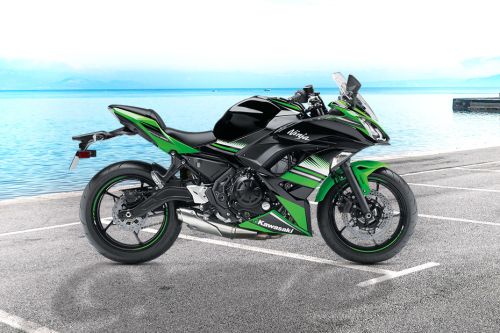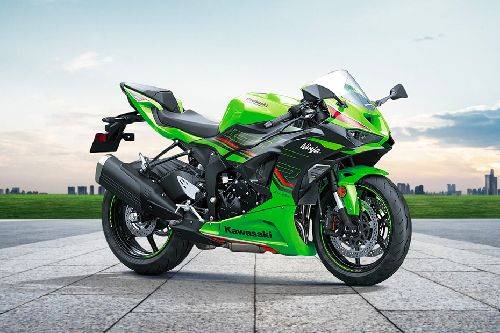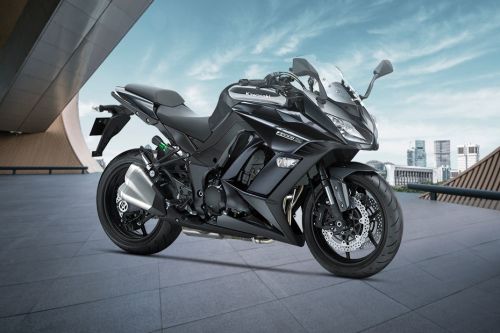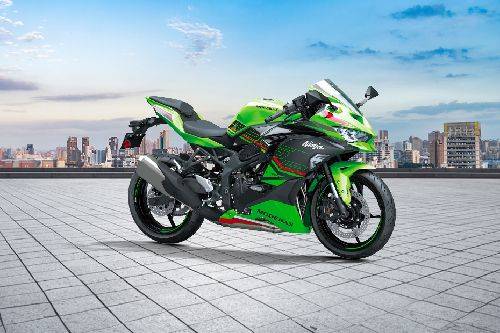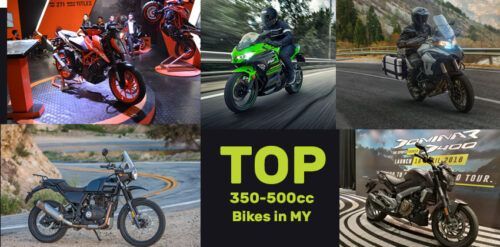Ninja 400 Pros & Cons
Get the better insight and helps to buy or notHigh performance
Excellent ride quality
Impressive looks
A high price tag
Recent Updates of Kawasaki Ninja 400
The Ninja 400 recently received an update for the 2022 model year and now comes powered by a Euro-5 compliant 399cc liquid-cooled parallel-twin engine that makes 45.3PS of power and 37Nm of torque. It also comes with new colour options that accentuate its sporty character. The slip and assist clutch has also been updated and now features 20% lighter lever action than before. The suspension unit continues to have the same 41mm telescopic front forks and pre-load adjustable mono-shock on the rear. Stopping power comes from a 310mm disc brake at the front and a 220mm disc on the rear with ABS.
Gallery of Ninja 400
- exterior
Kawasaki Ninja 400 Exterior Images
Exterior ImagesKawasaki Ninja 400 has 7 images of its exterior, top Kawasaki Ninja 400 2025 exterior images include Slant Rear View Full Image, Left Side View Full Image, Right Side Viewfull Image, Head Light View, Back Side View, Slant Upfront View, Slant Back Side View Right.
Read MoreNinja 400 Features Highlights
Kawasaki Ninja 400 Review 2025
Abhishek Katariya says
The Ninja 400 is Kawasaki's small-capacity supersport motorcycle whose latest 2021 model was unveiled at a global level last year. However, there is still no confirmation of it reaching the Malaysian market. The Ninja 400 was first launched in the country as an extension to the Ninja 250 R and was very well received in the market. Clad in sharp new Ninja styling, the Ninja 400 delivers better performance than its predecessor, thanks to the all-new engine and chassis that are more powerful and significantly lighter. Not only does the Ninja 400 SE ABS offer stunning looks, its robust engine performance, along with light handling and relaxed, sporty riding position, make it a great ride. It comes equipped with high-class and futuristic features like the twin LED headlamps that offer significantly increased brightness and the high-grade cockpit equipped with the same instrument cluster as the Ninja 650. Other notable features include economical riding indicator, Anti-lock Braking System (ABS), Assist and Slipper clutch, and ERGO-FIT. The Kawasaki Ninja 400 is offered in a single variant, SE ABS, which primarily contests against the Honda CBR 500R and the Honda CBR 250RR.
Overview |
|
| Brand | Kawasaki Malaysia |
| Body Type | Sport |
Powertrain |
|
| Engine | 399 cc |
| Transmission Type | Manual |
| Power Output | 45 hp and 38 Nm of torque |
| Fuel Type | Petrol |
| Drive Type | Chain Drive |
Dimensions |
|
| Seating Capacity | 2 Seater |
| Width | 710 mm |
| Length | 1990 mm |
| Height | 1150 mm |
| Ground Clearance | 140 mm |
Kawasaki Ninja 400 Design
The Ninja 400 gets a sturdy yet lightweight body that is complemented by its futuristic and sharp design language. The H2 inspired fangs of this bike combined with the twin LED headlamps to offer a bold look to the front end. The headlamps are highly visible and offer significant brightness. The visual appeal is further enhanced by the lime green and black colour, which now gets honeycomb graphics on the side fairing and hints of red on the front fairing and underbelly. At the rear, you get a sharp tail light embodied into the seat and sharp turn indicators. The Ninja 400 is equipped with exactly the same instrument cluster as the Ninja 650, adding to the high-grade feel of the cockpit. The refined instrument panel design features a large analog tachometer surrounded by warning lamps on one side, and a multi-function LCD screen, and a gear position indicator on the other. A clean design omitted any unnecessary items, and a revamped layout enabled a slim engine and a cooling system with a bare minimum of external piping.
Ninja 400 Ride & Handling
Thick cushioning, low vibration seats made of low-rebound urethane contribute to superb ride comfort. Suspension setup comprises 41 mm telescopic front forks and Bottom-Link Uni-Trak with gas-charged shock with adjustable preload at the rear. Kawasaki has fitted the Ninja 400 with a trellis frame, quite similar to the one on the Ninja H2, which contributes significantly to the bike's low curb mass. Moreover, The new chassis features a short wheelbase and a long swingarm design, complemented by a steep caster angle, to deliver light, natural and effortless handling. A relaxed rider triangle is good enough to accommodate a variety of rider sizes and riding situations. The raised handle position and slightly foot forward footpeg position put the rider in an excellent position to control the bike while being in a comfortable position. A cover for the radiator fan helps direct the engine heat away from the rider, contributing to rider comfort.
Kawasaki Ninja 400 Engine & Fuel Consumption
Hauling the Ninja 400 is a 399cc, liquid-cooled, 4-stroke, 8-valves, parallel-twin DOHC engine. The new engine delivers significantly improved performance compared to its predecessor - maximum power of 45 PS at 10,000 rpm and peak torque of 38 Nm at 8,000 rpm. This power is transmitted to the wheels using a 6-speed gearbox. The better performance of the Ninja 400 is a result of the new downdraft intake and a larger airbox offering increased intake efficiency. Besides, a more compact clutch with less rigid operating plates offers a lighter lever pull, almost 20 percent lighter. The new clutch has a more comprehensive engagement range, facilitating control. The engine layout was optimised for size, weight, and efficiency. Despite the large displacement, the weight is kept to a minimum.
Ninja 400 Braking & Safety
In terms of braking, the Ninja 400 is equipped with 310 mm single semi-floating discs, along with a single balanced actuation dual-piston, at the front and 220 mm petal disc along with dual-piston at the rear. The rigid new front brake master cylinder eliminates idle stroke to offer more control, while meticulously selected brake hose material and dimension contribute to the brake touch. The Ninja 400 also features the latest ABS unit from Nissin, which is the most compact and lightweight unit available.
Kawasaki Ninja 400 Verdict
With a better, bigger engine, the Ninja 400 is a perfect upgrade to its predecessor. The bike offers a power-packed performance and looks stunning. Kawasaki has made all possible attempts to use technology to deliver excellent performance, ride quality, and features. The price is on a higher side, but then it's aimed at the niche market.
Kawasaki Ninja 400 Owner Reviews
Write a Review- All (19)
- Specs (6)
- Mileage (2)
Latest Question
Q. What is the Kawasaki Ninja 400 top speed?
Q. What is the Kawasaki Ninja 400 seat height?
Q. What is the Kawasaki Ninja 400 fuel tank capacity?
Q. What is the Kawasaki Ninja 400 Ground Clearance?
Q. What are the colors options available in Kawasaki Ninja 400?
Other Kawasaki Ninja 400 Motorcycles
Kawasaki Featured Motorcycles
Nearest Kawasaki Showrooms
Kawasaki Ninja 400 News and Reviews
- Ninja 400 News
- Ninja 400 Featured Article












